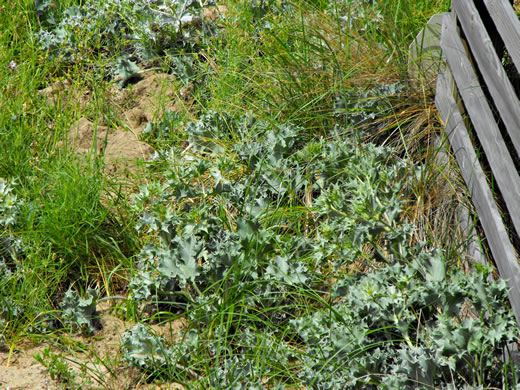Spermatophytes (seed plants): Angiosperms (flowering plants): Eudicots: Core Eudicots: Asterids: Campanulids: Apiales
WEAKLEY'S FLORA OF THE SOUTHEASTERN US (4/24/22):
Eryngium maritimum
FAMILY
Apiaceae
Go to FSUS key
Dig deeper at SERNEC, a consortium of southeastern herbaria.
Read more about Sea Holly at Vascular Plants of North Carolina.
SYNONYMOUS WITH
PLANTS NATIONAL DATABASE:
Eryngium maritimum
FAMILY
Apiaceae
SYNONYMOUS WITH VASCULAR FLORA OF THE CAROLINAS (Radford, Ahles, & Bell, 1968) 140-04-004:
Eryngium maritimum FAMILY Apiaceae
COMMON NAME:
Sea Holly, Seaside Eryngo
To see larger pictures, click or hover over the thumbnails.
Jan Haldeman jhh_eryngium_maritimum_in
May Dare County NC
Bracts 3-5 spined, coriaceous, 0.5-3cm long & broad, exceeding the heads, per Vascular Flora of the Carolinas (Radford, Ahles, & Bell, 1968).
Jan Haldeman jhh_eryngium_maritimum_l
May Dare County NC
Leaves thickly coriaceous, palmately lobed and tipped with stout spines, per Weakley's Flora.
WEAKLEY'S FLORA OF THE SOUTHEASTERN US (4/24/22):
Eryngium maritimum
FAMILY
Apiaceae
SYNONYMOUS WITH
PLANTS NATIONAL DATABASE:
Eryngium maritimum
FAMILY
Apiaceae
SYNONYMOUS WITH
VASCULAR FLORA OF THE CAROLINAS (Radford, Ahles, & Bell, 1968) 140-04-004:
Eryngium maritimum
FAMILY
Apiaceae
If a search such as "Carex leptalea var. leptalea" doesn't deliver the results you want, try "Carex leptalea".
Or, to minimize chances of a misspelling, try just "Carex le".
Less is more: If "pencil flower" doesn't deliver the results you want, try "pencil".




